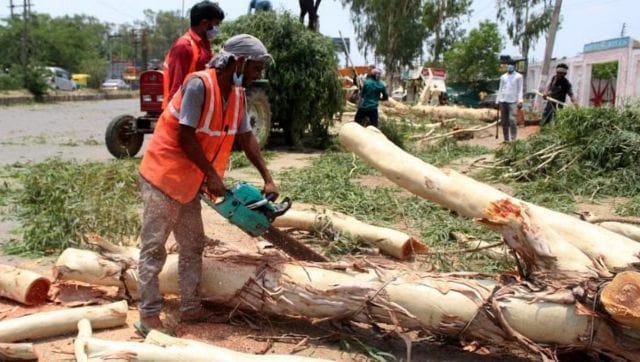Chief Justice of India Dhananjaya Y Chandrachud has stepped in to address an unusual standoff between two Supreme Court benches involving a case regarding illegal tree-felling in Delhi’s Ridge area.
The conflict emerged last month when two Supreme Court benches began handling different aspects of the same contempt case against the Delhi Development Authority (DDA), creating a potential judicial showdown.
To prevent further conflict, the CJI, along with Justices JB Pardiwala and Manoj Misra, formed a new bench that will take over the case, with the CJI himself set to preside over the hearing on Thursday.
This case, which has drawn considerable attention, involves allegations of unauthorised tree-cutting in one of Delhi’s most ecologically sensitive zones. What is the case and how did this issue escalate in the apex court? Let’s take a closer look.
The dual proceedings
The conflict between the two Supreme Court benches began when a panel led by Justices Bhushan R. Gavai and Sandeep Mehta, known as the forest bench, was hearing a case against the Delhi Development Authority (DDA) as part of the ongoing TN Godavarman forest conservation proceedings.
On April 24, the Gavai-led bench issued a contempt notice to DDA Vice-Chairman Subhasish Panda, for allegedly felling trees in Delhi’s Ridge area without proper permissions.
Tensions heightened in May when another Supreme Court bench, led by Justices Abhay S Oka and Ujjal Bhuyan, took up a separate contempt petition against the DDA. This petition was filed by concerned citizen Bindu Kapurea, who sought action against the statutory body for tree felling in the ridge forest area to construct a road from Chhattarpur to South Asian University.
During these hearings, Justice Oka’s bench questioned the involvement of Delhi Lieutenant Governor VK Saxena, who also chairs the DDA, in ordering the tree felling. The court strongly criticised the DDA for allegedly covering up the extent of the tree felling, Live Law reported.
Earlier in March, The apex court had refused permission to DDA to fell 1,051 trees saying that their application is very vague, Economic Times reported. It had added that the DDA being an instrumentality of the State, it is their duty to first make an attempt to protect the environment by requesting for the felling of only those trees that are absolutely necessary.
Further on July 12, Justice Oka’s bench warned that it would issue a contempt notice to the Lieutenant Governor for ordering the tree chopping and scheduled the next hearing for July 31.
However, on July 24, Senior Advocate Vikas Singh, representing Panda, informed Justice Gavai’s bench that the road needed to be widened to 24 metres to facilitate the inauguration of the Central Armed Police Forces Institute of Medical Sciences (CAPFIMS) Hospital, which had been delayed due to this issue.
Singh also highlighted the earlier contempt notice issued by Justice Oka’s bench, prompting Justice Gavai to question how another bench could proceed with the contempt plea when his bench had already issued a notice on the matter in April.
‘Other bench didn’t adhere to judicial propriety’
Justice Gavai’s bench questioned the decision of Justice Oka’s bench to entertain a contempt plea and run parallel proceedings when the forest bench was already dealing with a similar issue.
“On the question of propriety when one bench is seized of the contempt proceedings, should the other bench have proceeded in contempt? The other bench has not adhered to judicial propriety,” remarked the forest bench.
Justice Gavai expressed concern that having two benches simultaneously address the same issue could lead to contradictory judgments, thereby jeopardising the court’s authority and coherence.
The bench noted, “It would have been more appropriate for the other bench to seek clarification from the CJI before initiating contempt proceedings for the same course of action to ascertain which bench should continue hearing the contempt proceedings.”
To address the potential for conflicting orders and ensure judicial propriety, Justice Gavai referred the matter to the CJI to determine which bench should take over the case. As the head of the Supreme Court, the CJI is responsible for assigning cases to different benches.
In a decisive move, Justice Chandrachud has taken the matter under his own bench to prevent future disputes between benches and to maintain a unified stance of the country’s top court.
With input from agencies
Link to article –
What is the tree-felling case that Chief Justice DY Chandrachud has taken up?
